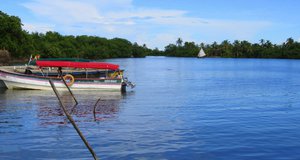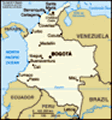Advertisement
Published: October 27th 2014

 San Blas Archipelago
San Blas Archipelago
At the docks in Carti, the trip beginsThis blog is a bit earlier than planned, but it is raining now and that is always a good day to do some writing. I thought about singing in the rain, but this seems a more productive way of spending my time.
I'm in Cartagena, pearl in the crown of the former Spanish possession in the Americas. Nowadays surely one of the most beautiful cities in Colombia, though that is just guessing, since I haven't seen any other towns. But this story will be more about how I got here than about the town itself. You see to get to Colombia from Panama you must cross the infamous Darien gap, no easy task.
So, instead of actually trying to hack my way through the impenetrable jungles and assorted drug smugglers and guerrilla groups that call Darien their home, I opted for the far more leisurely and safer option of taking a boat to Colombia. There are basically three ways of doing this, on your own, but that requires time, a commodity I am short of on this particular trip. The second option and the more popular one is a sailing boat to Cartagena, and finally a speed boat along

 San Blas Archipelago
San Blas Archipelago
Our speed-boat.
Photo courtesy of Arthurothe Panamanian coast which drops you off just across the border in a small village called Capurgana, unreachable by land from the rest of Colombia.
Both the sailing boats and the speed boats stay for three days in the San Blas Archipelago which stretches along the Panamanian coast towards Colombia. The difference being that the sailing boats remain in the northern part for those days, before making the sea-crossing to Cartagena, while the speed boat takes you along the entire string of islands from north to south hopping from one to another in its mad dash for the Colombian frontier.
There are many sailing boats, but there is only one company that offers the speed boat tour, hence as you leave the northern islands you leave the other tourists behind, which is one of the reasons I decided for this option. The other enticement for me was the fact that it didn't end in Cartagena, but in Capurgana, of which I had heard some nice stories.
So, the speedy option it was. A tour. I don't like taking tours, but sometimes you have no choice. I was a little bit daunted by the prospect I must say.

 San Blas Archipelago
San Blas Archipelago
One of the many islands along the way.
Photo courtesy of ArthuroYou never know how it is going to be, who will be on the trip, what it will be like. I'm not often seen in big groups, I wasn't sure how well I would fit in. As it turned out we all got along splendidly and our guide was great. Fourteen individuals, from seven different countries, most of us single travellers, its probably the reason why it all worked out so well. Our guide was a lovely American lass. No, not Panamanian or from the Kuna tribe who own the archipelago and administer them as an autonomous region, but an American, called Olivia, from Texas of all places. She knew her ropes though, and I don't think a Panamanian or Kuna could have done it better.
The tour Three days of island hopping. More or less two to three hours each day spent on the speed boat. Our first night was on a lovely small island with just one family on it. Think white sandy beaches, swaying palm trees and turquoise waters and you get the picture. Bedding was hammock style. Dinners invariably consisted of sea-food, lobster, squid and octopus galore. Fine dining at its best. Day time

 San Blas Archipelago
San Blas Archipelago
The island we spent our first night at, Isla Coco Bandera
Photo courtesy of Tessactivities involved such strenuous undertakings as floating in the water, swimming to another nearby picture perfect island, snorkeling or simply laying on the beach. Yes, it was hard work!
Second day we spent the morning on the same island, speeded away for about fifteen minutes before stopping on a pea-sized heap of gorgeous white sand and palm trees for lunch and more hard work, before a two hour slog to a village island inhabited by about fifteen hundred Kuna, where the night was spent. It gave everybody a chance to see a Kuna community in action.
Day three arrived with promises of beauty and relaxation. Two hours on the boat before arriving at yet another uninhabited island, bigger than most, with a hill on it and obviously a very fine stretch of sand. Lunch, was followed by some snorkeling and a short hike up the hill for the views. Night was on another village island, with a guided tour by Olivia.
And so the final day dawned, in which we first went to Peurto Obaldia on the Panamanian side to get stamped out before proceeding to our final destination, Capurgana in Colombia, where entry formalities were simple

 San Blas Archipelago
San Blas Archipelago
Nearby islands as seen from our island.
Photo courtesy of Gabrielaand straight forward. A final lunch and than it was all over. The tour that is, as everybody had to stay at least one day in Capurgana due to its connections to the rest of Colombia being with a early morning boat to Turbo. As it was everybody decided to stay for a couple of nights in Capurgana, and some longer still.
The Kuna They own the San Blas Archipelago, literally! Every family owns an island, and the only way as a foreigner to get your hands on one is to marry a Kuna girl. They women rule the roost here, and men move in with the girls family not the other way around. It is also the women who inherit. The chiefs however seem to be men. Albinos are held in high esteem and seen as protectors of the community. The Kuna have their own autonomous region in Panama which apart from the islands also includes a strip of mainland. Their main export article is coconuts, a cartel system ensures the prices remain stable, other sources of income are obviously tourism and fishing. The dress is distinct, especially for the women, and children are in abundance.
The group As mentioned, a friendly collection of individuals, roughly half female, half male. The nationalities ranged from Iceland (three of them, what are the chances!) to New Zealand, Canada, Finland, England, Germany, Poland and of course one Dutch to top it off. The group dynamics were good, though you always feel a bit of pressure to join in the drinking and social activities. That has nothing to do with the people, it is just humans in larger congregations. The pressure doesn't particular have to stem from others, you might just feel it yourself, the feeling you might be missing out if you don't participate. As much as I liked the group, and I certainly did, I was also happy to leave in the end. I am much too much of a loner to be able to stay long within one set of people. I wanted to go out and explore on my own again, and not move in a pack anymore. That said, I would like to thank all of them, should they be reading this blog. You were great, couldn't have asked for better.
Finally, Cartagena, reached by a boat to Turbo and from

 San Blas Archipelago
San Blas Archipelago
The family that owned the island.
Photo courtesy of Gabrielathere a ten hour bus ride. I've got a room for myself in a tiny brand spanking new hostel, with nearly nobody else in it. I am loving it, some private time. Time to collect my thoughts, decide on what's next and go wandering around this splendid city. A town of colourful colonial houses full of flower covered balconies, of massive city walls perfect for strolling on or enjoying a sunset, of troupes of dancing performers swirling around at night in shady parks lit by the yellow glow of swinging lanterns.
Yes, life is good!
Advertisement
Tot: 0.091s; Tpl: 0.017s; cc: 14; qc: 25; dbt: 0.0473s; 1; m:domysql w:travelblog (10.17.0.13); sld: 1;
; mem: 1.1mb























taracloud
Tara Cloud
Bounty Commercial!!!
What an idyll--swimming and snorkeling in warm water without a wetsuit! The voyage and islands sound lovely, and congratulations on surviving and thriving in a group and on a tour--something I too, avoid. I can imagine how lovely your own room in an almost-empty hostel must now be in gorgeous Cartagena. Layers of perfection!